Deep Time: “The lessons of the past inform the future”
Get a sneak peek of the new Fossil Hall from director Kirk Johnson
Kiren Jahangeer, a long-time volunteer at the National Museum of Natural History, took a very special tour of the David H. Koch Hall of Fossils—Deep Time with the museum’s director, Kirk Johnson.
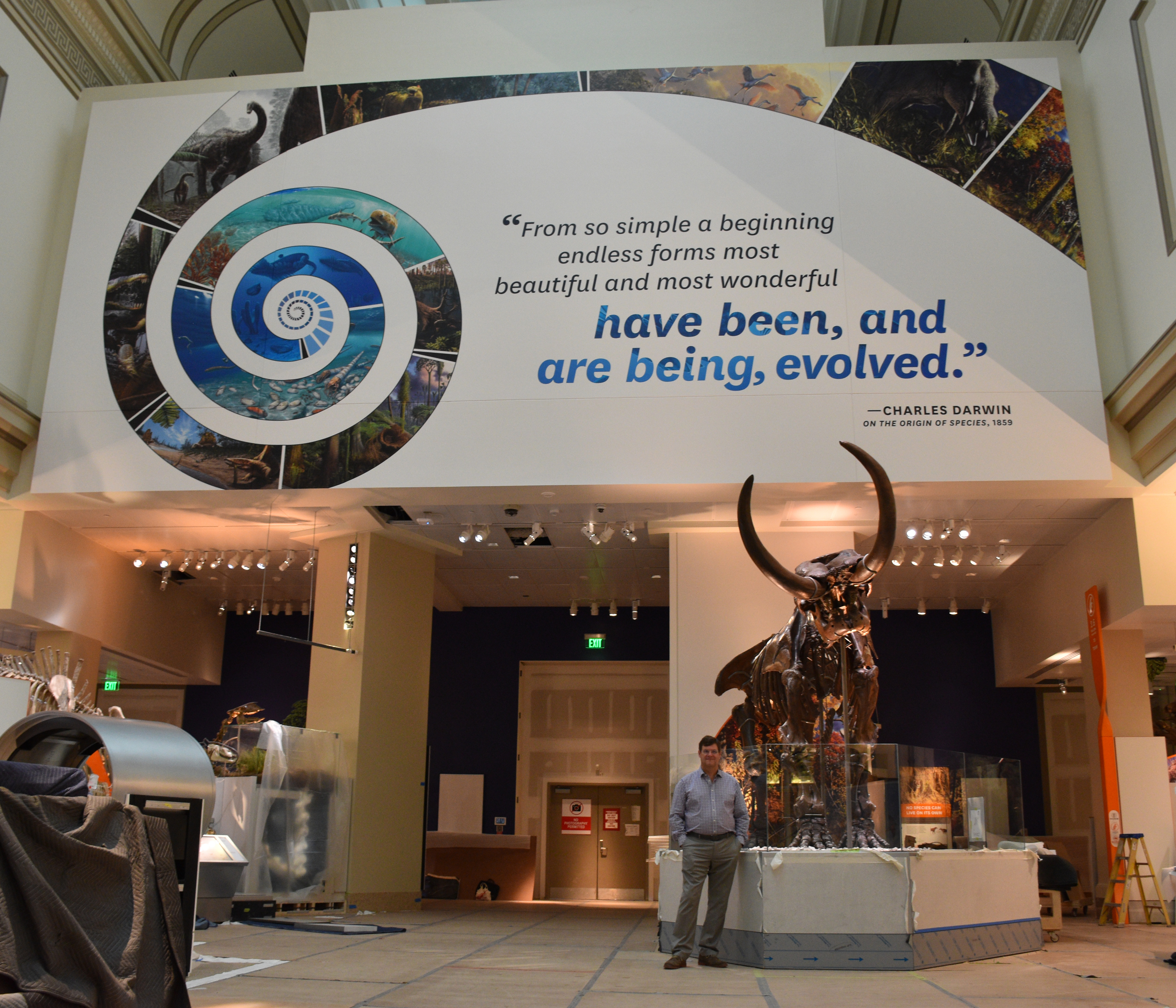
Kirk Johnson, director of the Smithsonian’s National Museum of Natural History, is dwarfed by a trumpeting mastodon in the “David H. Koch Hall of Fossils: Deep Time” still under construction. (Photo by Lisa Porter)
Dr. Kirk Johnson, director of the National Museum of Natural History, granted me an exclusive sneak peak of Deep Time several weeks before it opens to the public June 8. The new gallery—opening five years after Dinosaur Hall closed for renovation—represents the most extensive renovation in the museum’s more than 100-year history. The Dinosaur Hall has always been the most visited gallery in the most visited natural history museum in the world—five to six million people walk through these halls every year. So how can you close down your most popular exhibit for five years? Will Deep Time be worth the wait? I’ll end your suspense: Deep Time exceeds all my expectations—spectacularly so. Dr. Johnson, along with Dr. Matthew Carrano, Curator of Dinosauria, and Siobhan Starrs, project manager for the renovation, shared with me how they did it.
The plans for the renovation began in 2000, but it took over a decade to find a lead donor. In 2012, David H. Koch provided $35 million of the $64 million the renovation required. Under Johnson’s leadership, Carrano and the team made content decisions for the new hall, including critically important topics such as major extinctions, major climate events, major animal groups, and life in the ancient seas. Hundreds of staff were involved in the years-long renovation. Carrano explained that he has been brainstorming about this renovation since his first day at NMNH in 2003.
The making of the 31,000-square-foot “David H. Koch Hall of Fossils—Deep Time,” was a five-year project that involved the largest, most extensive building renovation in the museum’s history. Just within the confines of the fossil hall, interior walls that had been put into place during the past century were removed, structural columns under the Winston Gallery were relocated, all electrical and mechanical systems were updated, windows and the skylight were replaced and the wing’s historic atrium was revealed. To make way for the dinosaurs, almost every corner of the museum has been touched by the new exhibition in some way.
Back to the Future
You enter Deep Time into a bright wide-open pace, in contrast to the hall’s prior tight, dim feel. The skylights and original windows have been opened up to restore the room to how it would have looked in 1910. The brightness reflects a groundbreaking feature of the exhibit: the reversal of time. Every other prehistoric hall begins in the past, yet studies show this approach can be difficult for visitors. Deep Time begins in the ice age, 10,000-15,000 years ago, with the Giant sloth and American Mastodon and then goes back further in time the deeper you walk into the hall.
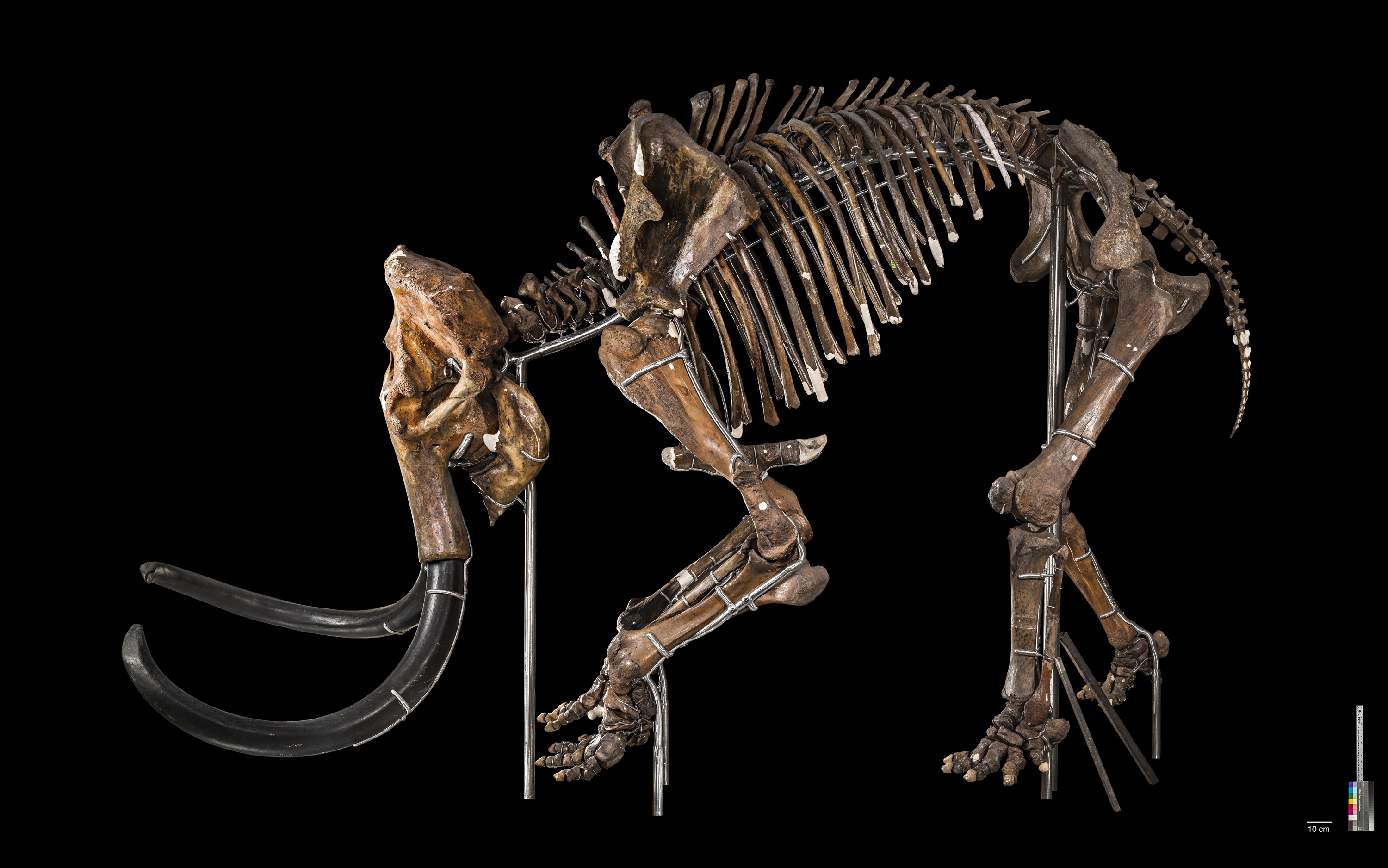
Woolly mammoths (Mammuthus primigenius), perhaps the best-known mammals of the ice ages, went extinct due to a combination of shifting climate, changing food sources and a new predator—humans. Even without other factors, rapid changes in climate can drive species toward extinction. (Photo by Gary Mulcahey, Smithsonian Institution)
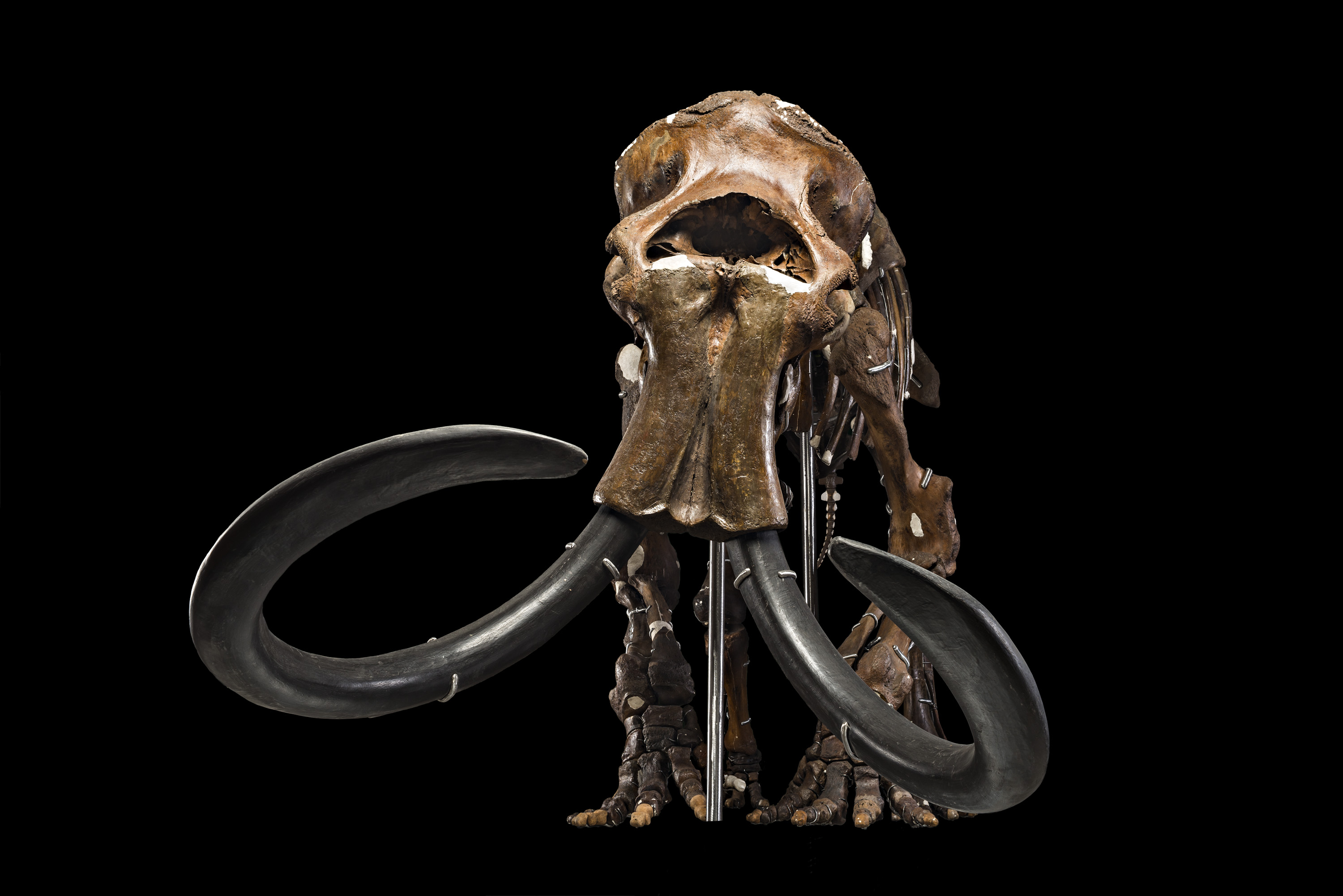
This mammoth skeleton, from the Paleobiology collections at the Smithsonian Institution National Museum of Natural History, is a composite – put together from the isolated bones of many individuals of the same size. Although they are less scientifically valuable, composite skeletons are very helpful for showing what a whole prehistoric animal looked like. (Photo by Gary Mulcahey, Smithsonian Institution)

Unlike the sloths known today, giant ground sloths, Eremotherium laurillardi, were massive, elephant-sized creatures that existed tens of thousands of years ago.
Today, these impressive herbivores are extinct, but their great stature and history can be appreciated once more at the “David H. Koch Hall of Fossils—Deep Time,” a 31,000-square-foot dinosaur and fossil hall, opening June 8 at the Smithsonian’s National Museum of Natural History. (Photo by Lucia RM Martino and Kate D. Sherwood, Smithsonian Institution)
Carrano revealed how staff were able to use data from other natural history museums when they planned this exhibit redesign. “We went to lots of other exhibits and did lots of research. We are one of the last major museums to renovate a dinosaur hall in the past 20 years,” he says. “The advantage of that is we can see what has and hasn’t worked in other museums. The beginning of the story of life on earth is challenging. It’s basically a biochemistry experiment, which is not the most fascinating thing to most people. You can’t see any of it so you are starting the story with a whisper. People aren’t familiar with it, and generally don’t care, so they skip the beginning and go straight to dinosaurs. They’re missing all of this content you’ve created which is very frustrating.”
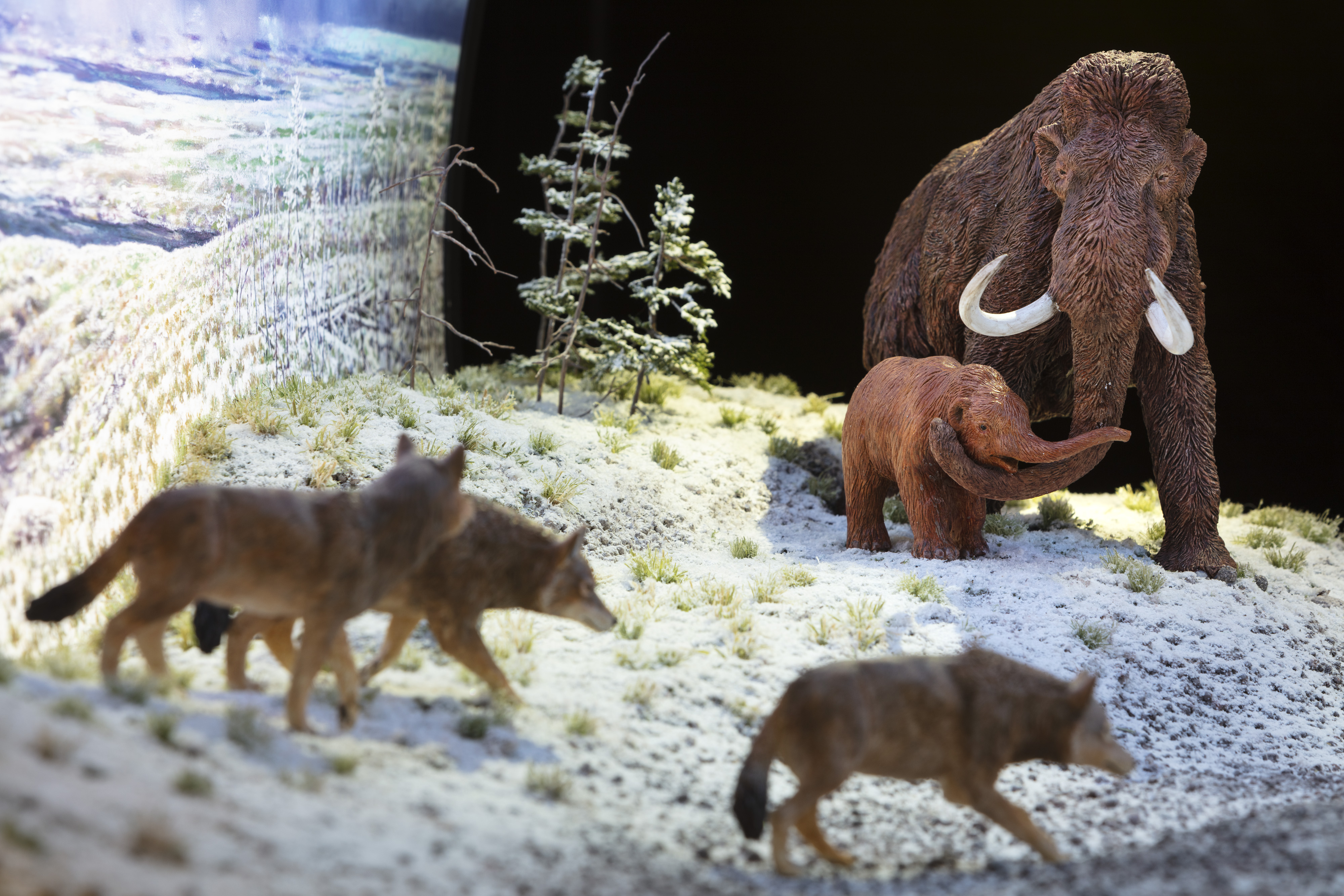
The “David H. Koch Hall of Fossils—Deep Time,” a 31,000-square-foot dinosaur and fossil hall, opening June 8 at the Smithsonian’s National Museum of Natural History, was a five-year renovation project. While this was the largest renovation in the museum’s history, no detail was missed by the scientists, curators, designers and artists involved. Life-size displays are accompanied by small dioramas that depict life as it once was. (Photo by Kate D. Sherwood and Lucia RM Martino, Smithsonian Institution)
“But why fight the visitor?” Carrano continues. “We decided to reverse time and bring people into the story in a place they want to be and that is relevant – because humans are already in the story, with the woolly mammoths and saber-tooth tigers that are visually appealing to people.”
Carrano hopes visitors can really see themselves as part of the story when they visit Deep Time. “We didn’t want this to feel like a day trip into an exotic world, but more that you are reading a chapter of a story of which you are a part. That underscored how we tried to think about the past as a way to think about the future. I hope people think about the scale of things–the earth as a very resilient place but also a place where there are times of great, unpredictable change. There have been moments of rapid climate change in the past, and that is part of the earth’s history, but when there is a lot of change in a short amount of time, that’s when things tend to go haywire. While life goes on, that life isn’t always what you might have predicted.”
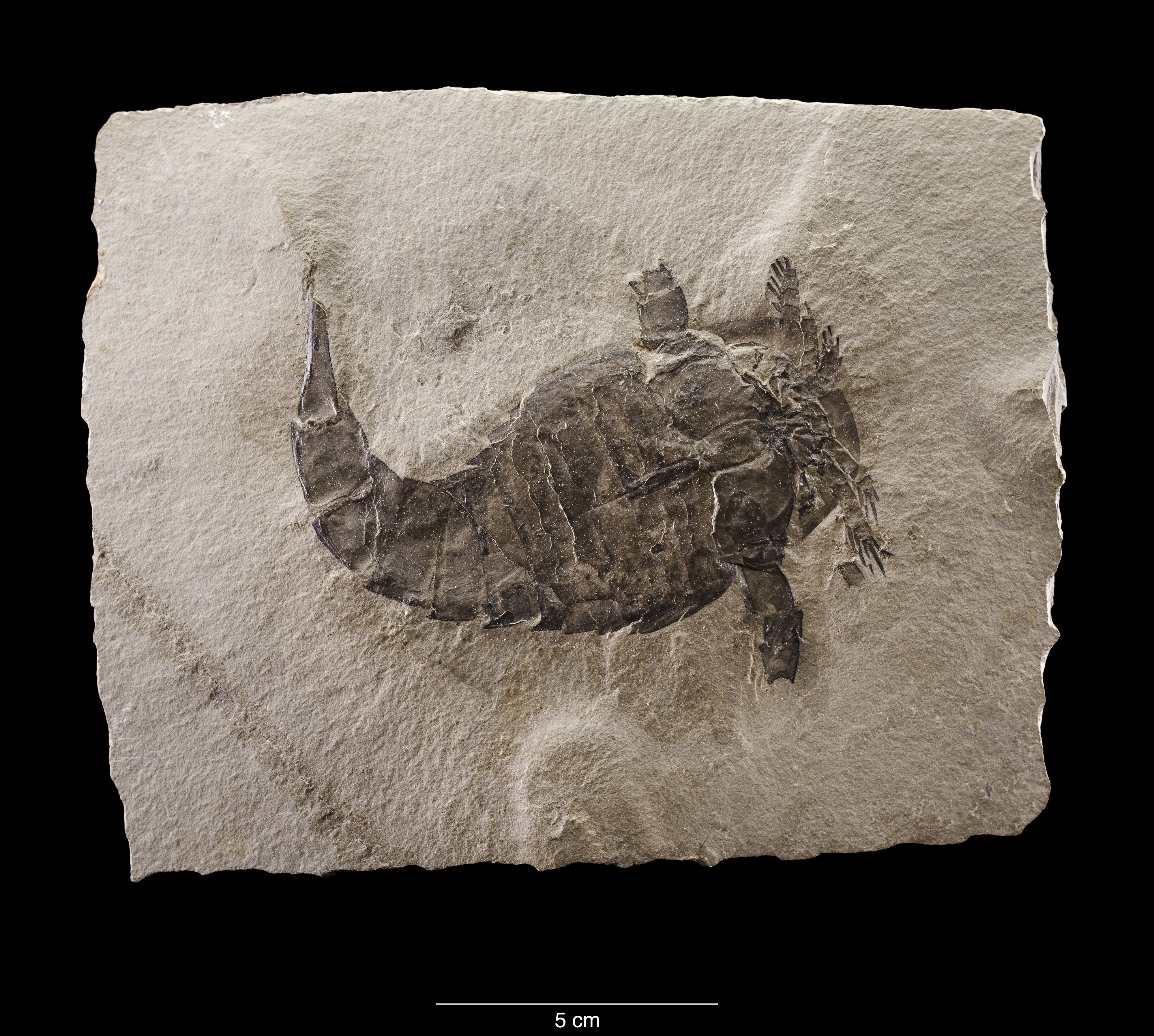
Eurypterus remipes
Animals began to settle on land once microbes and plants provided food and habitats. The first terrestrial arthropods included eurypterids making brief trips from shallow water to shore. They already had legs but faced challenges breathing and walking in thin, dry air. Over millions of years, many animal groups made the move from water to dry ground. (Photo by James Di Loreto)
The Age of Dinosaurs
When we arrive at the age of dinosaurs, you’ll notice first that they appear in dynamic poses—sleeping, scratching, fighting. Iconic specimens are used to illustrate the central narrative, while short films and interactive media explain more complicated topics. In the digital media, dinosaurs are depicted with feathers. Ancient landscapes are presented in miniature diorama form. The scientists have taken advantage of the renovation to present the specimens in new ways and some of the fossils now on view have never been displayed publicly.
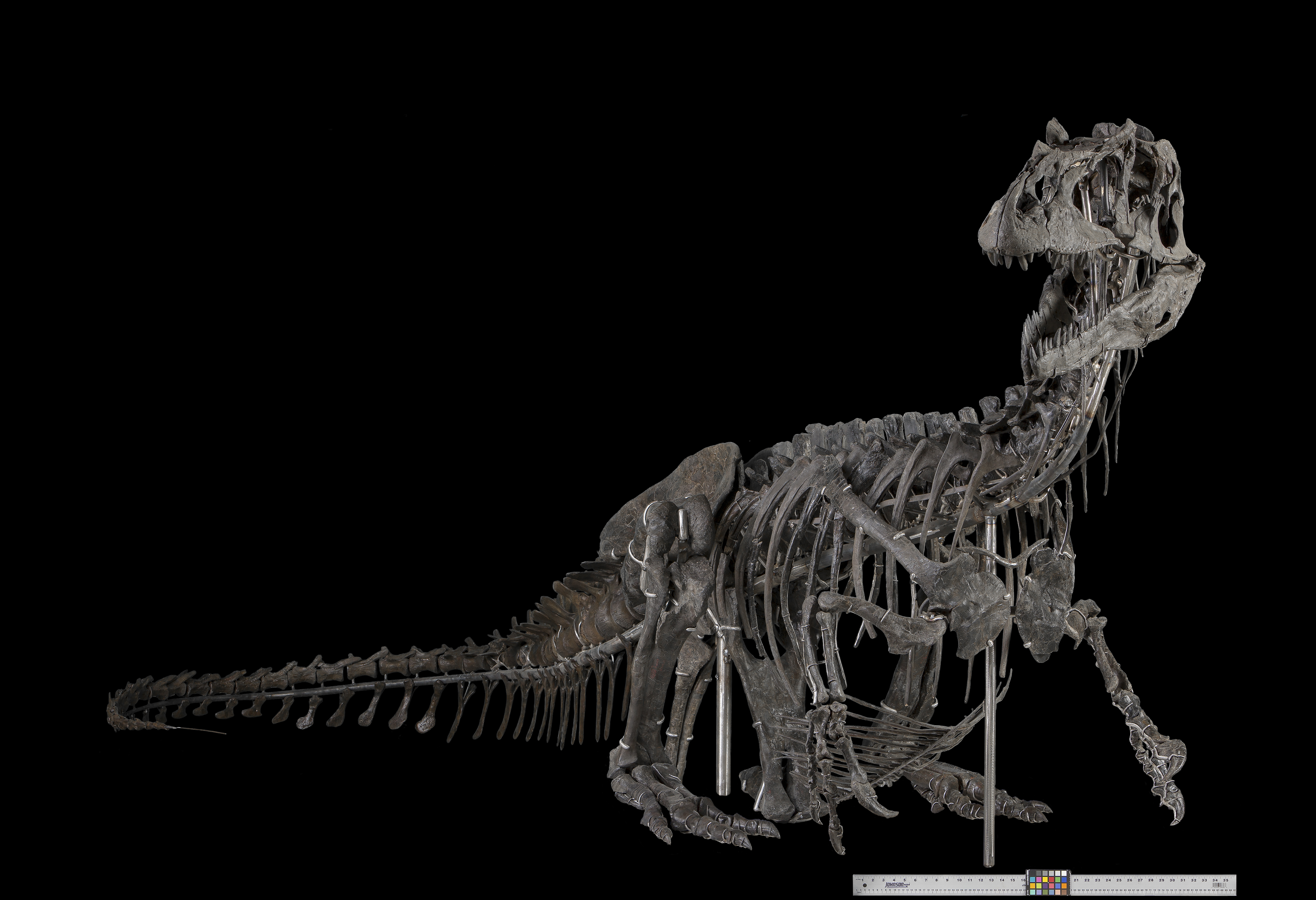
Theropod dinosaur, Allosaurus fragilis,
This Allosaurus fragilis skeleton was the first nearly complete Allosaurus found and is one of the most studied specimens of Allosaurus in the world. It will be on display in “The David H. Koch Hall of Fossils: Deep Time.” (Photo by Gary Mulcahey, Smithsonian Institution)
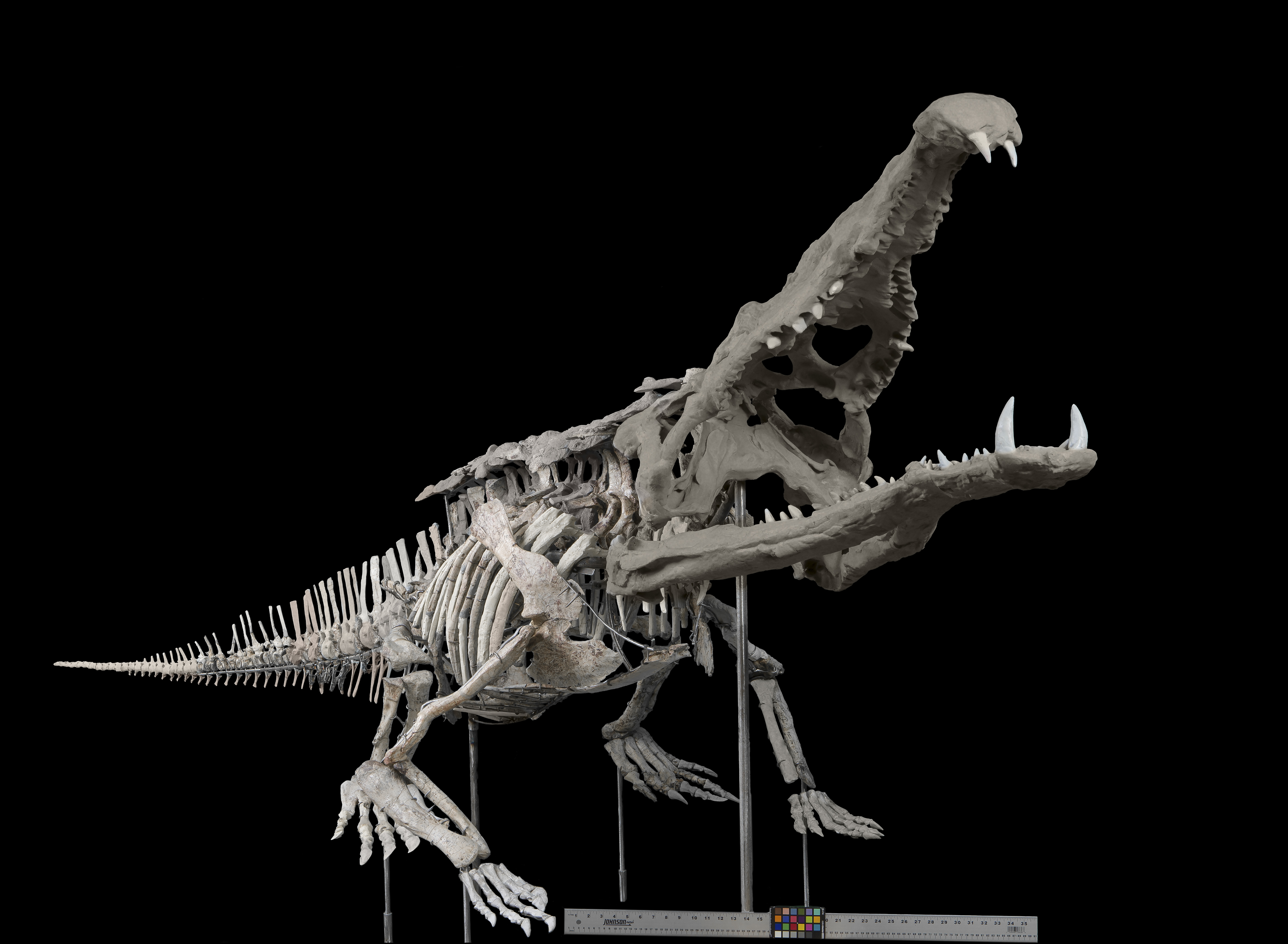
Smilosuchus gregorii
Phytosaurs resemble crocodiles, but they are not closely related. This is a case of convergent evolution: the two groups independently evolved similar features as adaptations to similar lifestyles. This Triassic land-dweller, Smilosuchus gregorii, will be on display in “The David H. Koch Hall of Fossils: Deep Time.” (Photo by Gary Mulcahey, Smithsonian Institution)
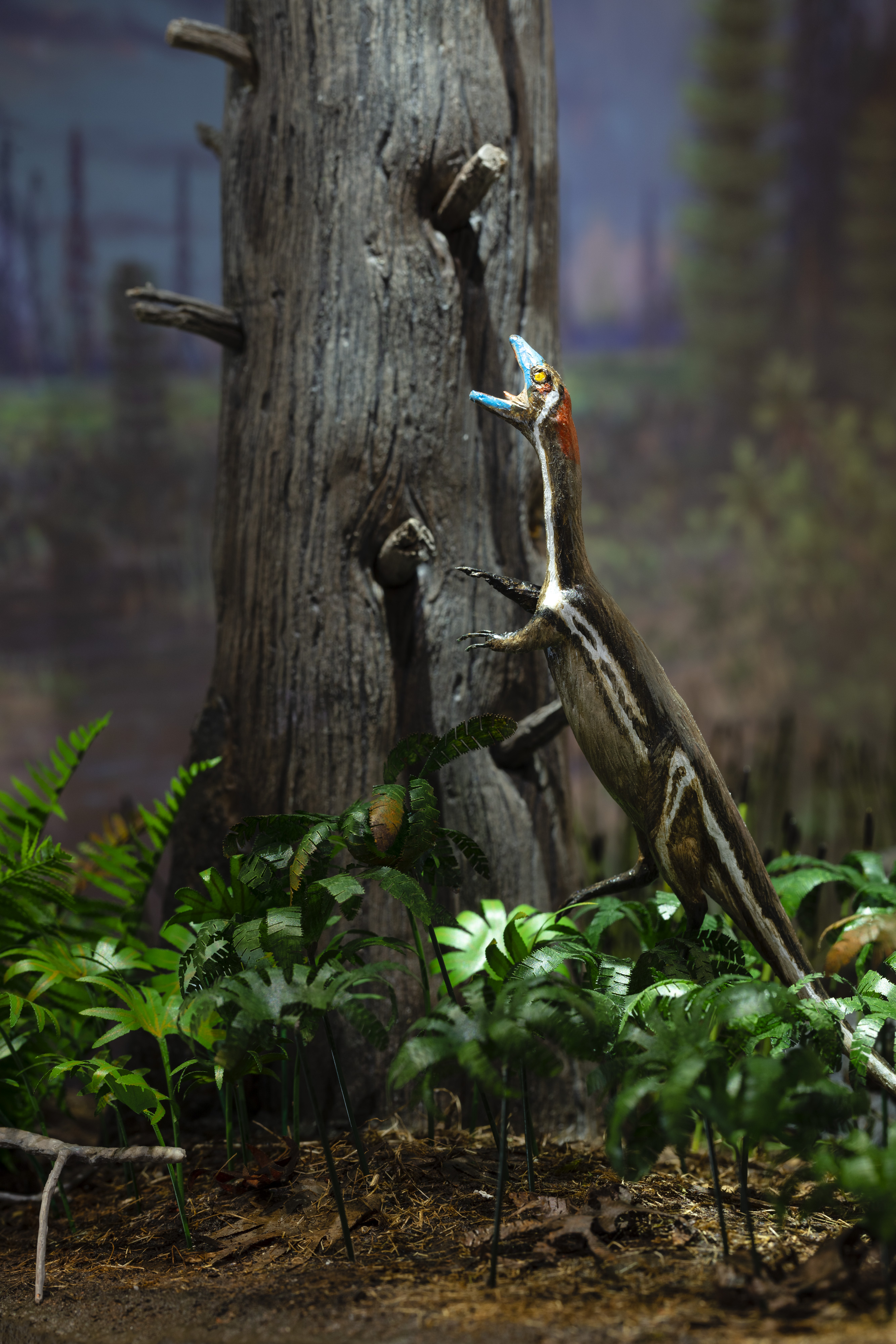
Reptile-like dinosaurs of all sizes once roamed the Earth, hunting for prey or scraps. Now, small, detailed replicas of the animals can be seen in the “David H. Koch Hall of Fossils—Deep Time,” a 31,000-square-foot dinosaur and fossil hall, opening June 8 at the Smithsonian’s National Museum of Natural History. The replicas are an example of the artistry and thought that went into every detail in the new exhibit. (Photo by Kate D. Sherwood and Lucia RM Martino, Smithsonian Institution)
The fossil prep lab is back, where visitors can watch scientists and volunteers excavate various specimens. There is a new interactive space (based on Q?RIUS) where visitors can learn how to find and date fossils, explore evolutionary concepts and even discover how they are related to a mushroom.
In the old hall, many specimens were only partially displayed–hidden under plaster, behind walls, or still in the original rock. Now, they have all been excavated and displayed to look like living organisms. Carrano says the most difficult specimen to excavate was Ceratosaurus, which took a full year with multiple people working on it. “Half of it was in the original rock, and it was all encased in plaster,” he explains. “We had to sculpt missing things. The skull was crushed, we had to re-inflate it. It was very hard rock, which is why it wasn’t completely excavated previously.”
One of the most spectacular exhibits is, of course, the Nation’s T. rex,, which was found in Montana in 1988 by Kathy Wankel and is on loan to NMNH from the U.S. Army Corps of Engineers for the next 45 years. It appears here with an unfortunate Triceratops caught in its jaws, in a pose sure to thrill generations of schoolchildren.
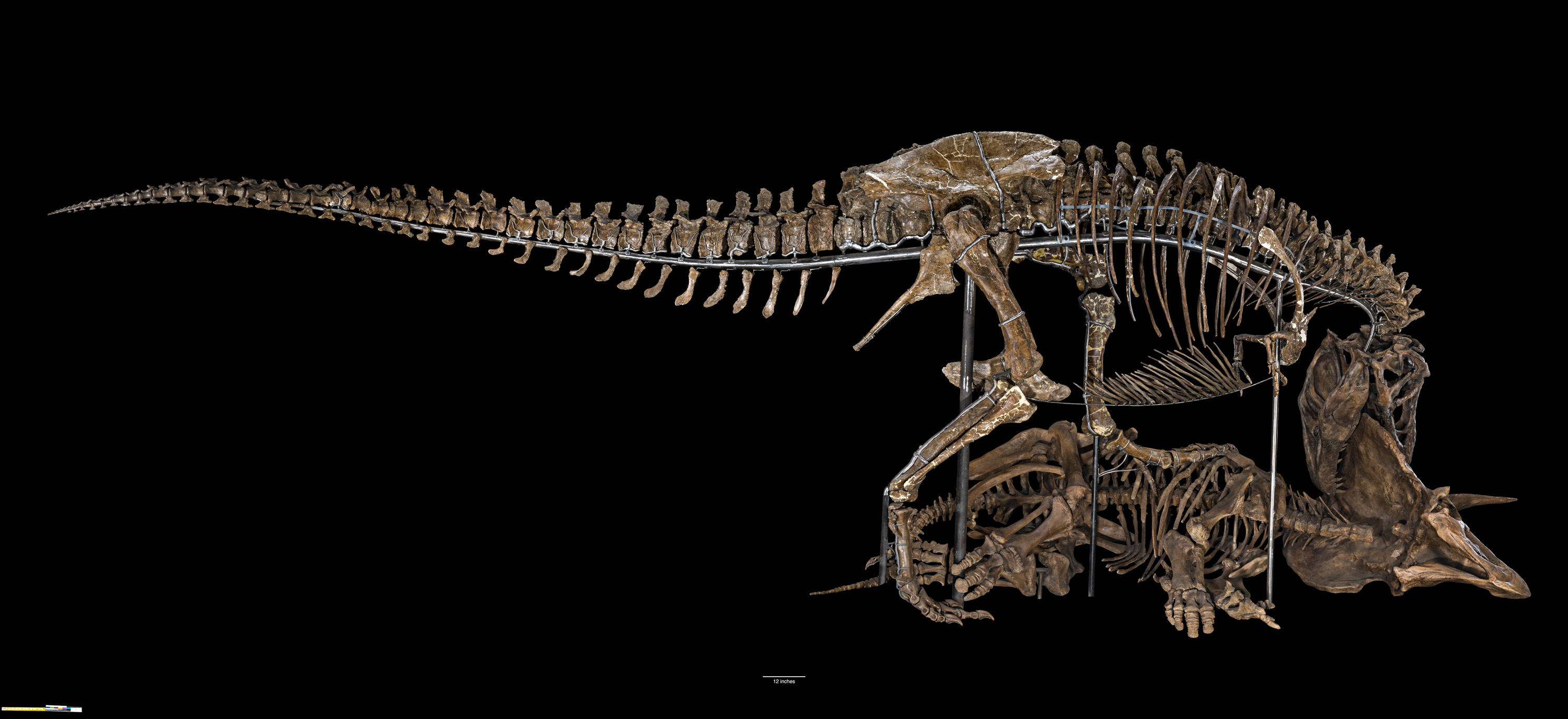
In its time, Tyrannosaurus was the largest meat eater in western North America. It feasted on dinosaurs large and small, including plant eaters like the Triceratops. Few—if any—animals could take down a healthy, adult Tyrannosaurus.
As the apex predator, the “tyrant king” affected the entire community. Each meal Tyrannosaurus killed or scavenged helped keep populations of some species in check and provided leftovers for others.
In its new pose devouring a Triceratops, the Nation’s T. rex will be the centerpiece of “The David H. Koch Hall of Fossils—Deep Time,” a 31,000-square-foot dinosaur and fossil hall opening June 8 at the Smithsonian’s National Museum of Natural History. (Photo by Gary Mulcahey, Smithsonian Institution)
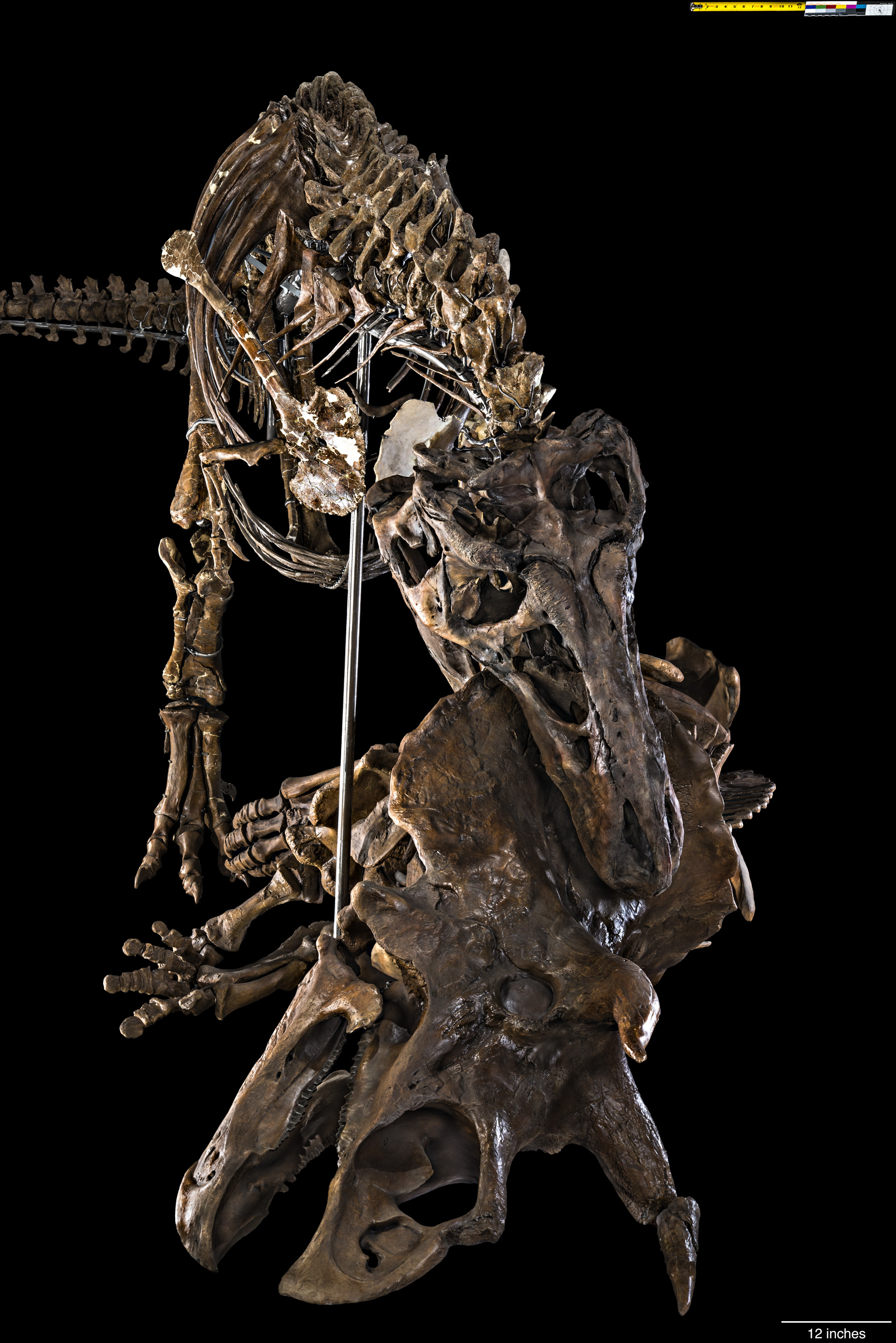
Anterior view of Tyrannosaurus rex biting the skull of Triceratops horridus.
In 1988, rancher Kathy Wankel discovered this Tyrannosaurus specimen while hiking on land managed by the U.S. Army Corps of Engineers. After a little digging with a garden shovel and a jackknife, she unearthed the first complete T. rex arm ever found. Dr. Jack Horner of the Museum of the Rockies led the mission to excavate the rest. This specimen was loaned to the Smithsonian in 2014 for 50 years, where it is to be displayed with the composite cast of a Triceratops horridus, assembled from the remains of several individual specimens. (Photo by Gary Mulcahey, Smithsonian Institution)
Besides the Nation’s T. rex, Johnson points out some of the other new and exciting acquisitions on display. “There are two pieces I’m particularly fond of,” he says. “There is a horse skeleton that is probably the most exquisite fossil ever found in North America. It’s a complete fossil horse that was found in Wyoming in 2004. Every single bone is completely attached. It’s an early horse, and it looks like he died in the pose he’s galloping in. Zero reconstruction was needed, it’s perfect. It’s the Hope diamond of Deep Time. There’s also a palm from Alaska that we collected live on television. If that doesn’t tell you about climate change, nothing will. The palm and the horse are the most exquisite pieces in the exhibit and my two favorites.”
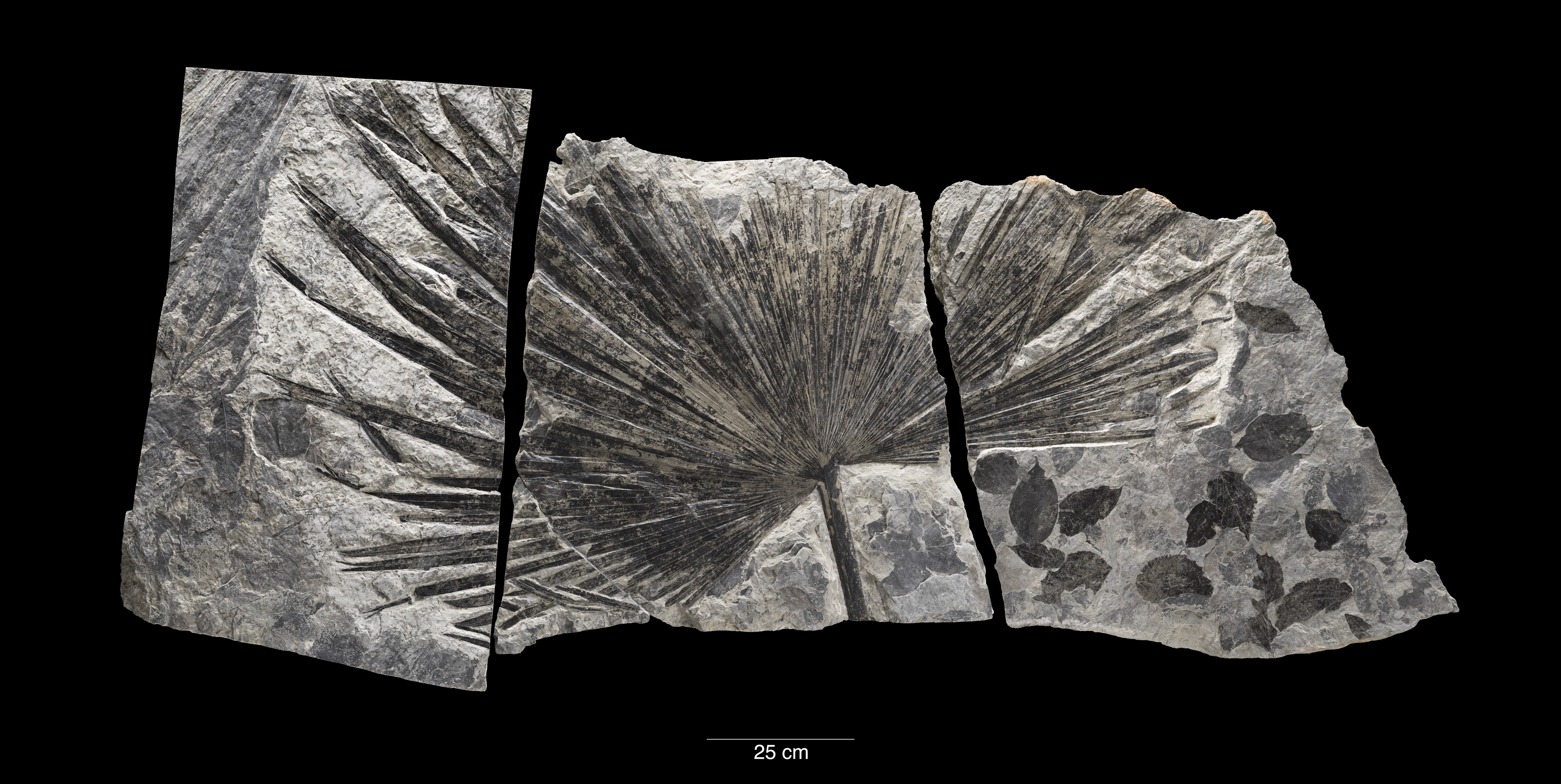
Sixty million years ago, the climate was warmer than it is today—from the equator to the poles. Dense, wet forests covered North America all the way to Alaska. How is it known that the climate was warmer? Many types of warm-climate plants, including palms, grew in places too cold for them now. This fossil palm leaf (Sabalites sp.), discovered in Petersburg Borough, Alaska, will be on display in “The David H. Koch Hall of Fossils—Deep Time,” opening June 8 at the Smithsonian’s National Museum of Natural History. (Photo by Lucia RM Martino, Fred Cochard and James Di Loreto, Smithsonian Institution)
The Age of Humans
The true heart of the exhibit is the Age of Humans, which explores human impact on the planet today–specifically, climate change. The museum’s curators have been careful to strike a tone that both conveys the urgency of the science, but also inspires hope. Studies show that if a message seems hopeless, people will give up and be unmotivated to act.
Deep Time is meant to stimulate social interactive learning, Johnson says. “We want to inspire people, not scare them, but there’s a genuine urgency out there. Ideally we are helping people understand how climate change works, and they can process that and make conclusions based on the science. We need to get people engaged, give them ideas for what works, the success stories, and maybe they will think, ‘I can do something about this.’ The general theme of the whole hall is to activate positive thinking and action about the future of the planet. We are a really important museum in helping people understand how the world works. This is a critical time in earth’s history for the human population. Climate change–that big, serious message, needs to be presented in a very profound and systematic way.”
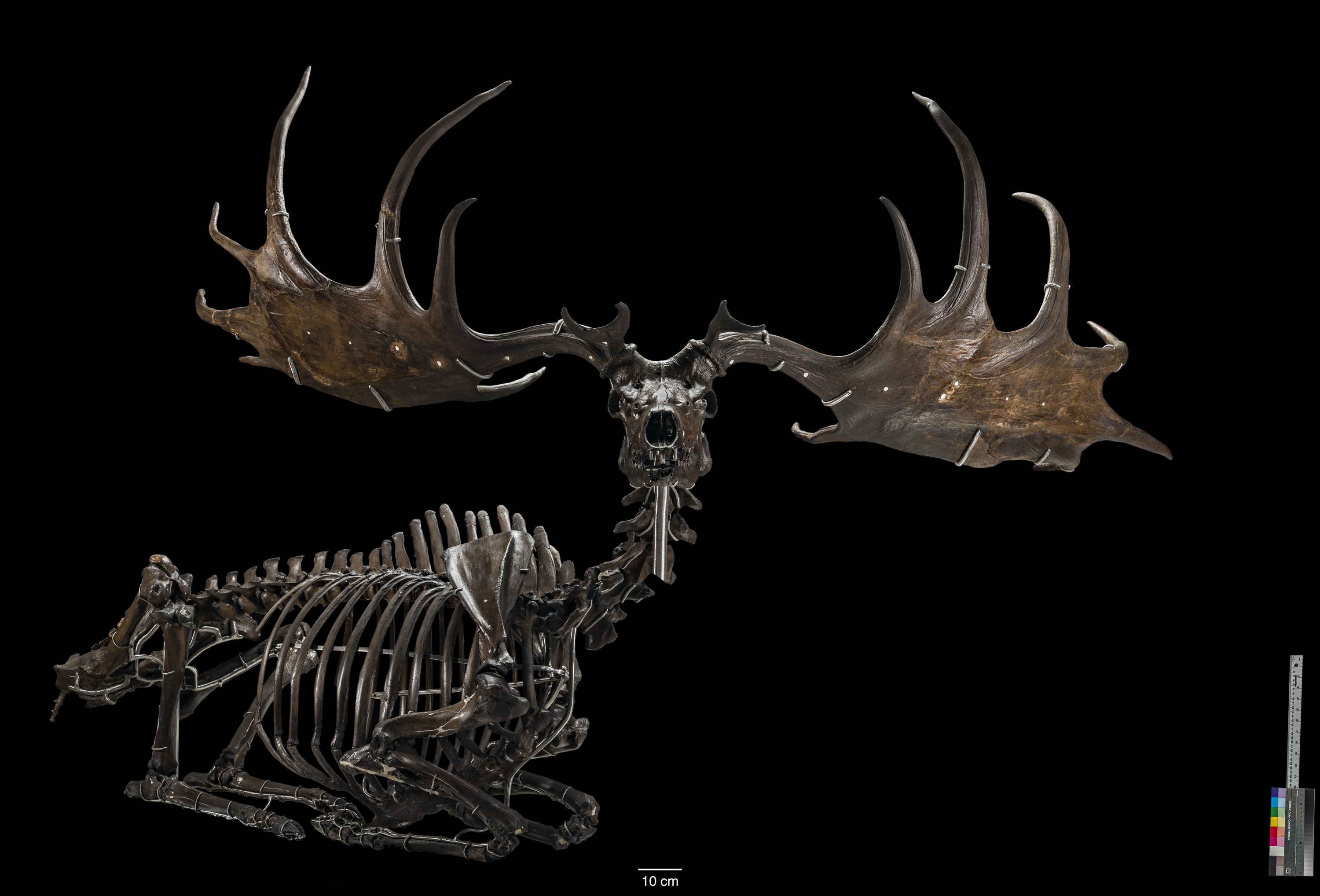
Often called the “Irish Elk,” Megaloceros giganteus ranged beyond Ireland and its closest living relative is the fallow deer, not the elk. Megaloceros lived across northern Eurasia from Siberia to Ireland, and like other deer, shed even these giant antlers every year. This specimen, from the Paleobiology collections at the Smithsonian Institution National Museum of Natural History, is the Smithsonian’s oldest mounted fossil skeleton, and has been on display since 1872. (Photo by Gary Mulcahey, Smithsonian Institution)
This exhibit addresses climate change in a way no other natural history museum in the world does, which is no small feat. Johnson adds “I’m sure there will be some resistance when the exhibit opens. Climate has become so politicized even though it’s just a scientific topic, like evolution. From my point of view, it’s one of the most important things about the hall. The dinosaur hall is very popular, especially for young kids, so this is a way for kids to not just understand dinosaurs, but also learn how the world works.”

“David H. Koch Hall of Fossils—Deep Time,” a 31,000-square-foot dinosaur and fossil hall, reveals the relationship between the spread of humans and the proliferation of animal extinction.
Visitors will be able to track the human migration and see in detail how ecosystems changed in their wake. (Photo by Lucia RM Martino and Kate D. Sherwood, Smithsonian Institution)
“There’s an event that happened 55.8 million years ago called the PETM (Paleocene-Eocene Thermal Maximum),” Johnson explains. “This was a very abrupt spike in global warming–the amount of carbon released in the atmosphere was about the same as if we burned all the carbon fossil fuels in the world today (which we are on track to do). This event is a good analog for the present day, except that the PETM occurred in what was already a warm world. We used to have polar forests, not polar ice caps. We can see what happened in the fossil record and determine how long it takes natural processes to draw excess CO2 out of the atmosphere—about 200,000 years. So if we burn our remaining fossil fuels in the next 100 years, we are committing the planet (with only natural processes to draw CO2 out) to 200,000 years to draw down. About the same length of time humans have been on earth. This perspective gives you a way of looking at the present climate situation with a real eye towards rates and times,” Johnson continues. “You realize what we are doing now will affect the planet for a really long time compared to how long humans have been on earth. If you don’t do something to mitigate the effects, you are making a deal now that will last for 200,000 years
The message for visitors
Toward the end of our tour, I asked Dr. Johnson what he hopes visitors will take away from their visit to Deep Time.
“Museums have changed my life. I know many people across many different fields have also had similar moments in museums that changed the way they think about the world. The museum experience is not like a formal education setting; it aims to inspire awe and wonder. For a young developing brain, it can be a fundamentally life changing experience. If even a small percentage of the visitors is influenced by what they see and learn, maybe we can solve the climate crisis. This is an urgent moment in earth’s history. At the end of the day, it takes really passionate, compelling people to inspire others to act. All you need is a single person around which movements coalesce. The human footprint on the planet now is massive. If we continue to do what we’ve done for the last 200,000 years, and the last 10,000 years, and the last 200 years, and very specifically the last 70 years, we are going to ruin the planet. If I were to sum up the theme of the hall in one sentence, it’s this: The lessons of the past inform the future. That’s what I want for visitors – I want to change lives, and change how people think about the world.”
Want to learn more? Check out the educational and public programs at NMNH.

Kiren Jahangeer shares a moment with actor David Duchovny. The truth is out there.
Kiren Jahangeer has been an Smithsonian volunteer since 2009. She has written for a number of SI publications, worked behind the scenes with the NMNH collections, assisted with educational programming at multiple museums, helped create exhibit content, and worked with donors. She worked with Dr. Johnson on an article about climate change and greenhouse gas emissions for the American Bar Association, where she was a writer. Kiren is the deputy press secretary for the American Association for Justice. She received her bachelor’s from Emory University, and her master’s in U.S. history from George Mason University.
Posted: 4 June 2019
-
Categories:
Feature Stories , Natural History Museum , News & Announcements , Science and Nature







